Dry eyes can disrupt daily life, but choosing the right eye drops can help. In 2025, advancements in eye care have introduced preservative-free formulas, improved hydration, and targeted prescription treatments. Here’s a quick look at the top options:
- Systane Complete PF: Preservative-free, great for sensitive eyes, and long-lasting hydration.
- Refresh Optive Preservative-Free: Dual-action formula for hydration and lubrication, ideal for sensitive eyes.
- TheraTears Lubricant: Mimics natural tears with an electrolyte-balanced formula, perfect for screen users.
- Thealoz Duo: Combines trehalose and hyaluronic acid for repair and moisture.
- Hyabak: Includes UV protection and sodium hyaluronate for outdoor use.
- Systane Ultra: Long-lasting relief with a dual-polymer blend, available in preserved and preservative-free options.
- Systane Gel Drops: Thicker formula for extended relief, especially at night.
- Refresh Celluvisc: Gel-like consistency for severe dryness, preservative-free.
- Restasis: Prescription drops targeting inflammation to boost natural tear production.
- Xiidra: Prescription drops offering quicker relief by reducing inflammation.
Quick Comparison
| Product | Key Feature | Best For | Price Range |
|---|---|---|---|
| Systane Complete PF | Preservative-free, broad lubrication | Frequent use, sensitive eyes | $$$ |
| Refresh Optive PF | Dual-action hydration & lubrication | Sensitive eyes, post-LASIK | $$ |
| TheraTears Lubricant | Electrolyte-balanced, mimics natural tears | Screen users, mild to moderate dryness | $ |
| Thealoz Duo | Trehalose + hyaluronic acid, preservative-free | Repair and moisture | $$$ |
| Hyabak | UV protection, sodium hyaluronate | Outdoor use, severe dryness | $$$ |
| Systane Ultra | Dual-polymer blend, long-lasting relief | Moderate to severe dryness | $$ |
| Systane Gel Drops | Thicker gel formula, extended relief | Nighttime use, severe dryness | $$ |
| Refresh Celluvisc | Gel-like, preservative-free | Severe dryness, sensitive eyes | $$ |
| Restasis | Prescription, reduces inflammation | Chronic dry eye, natural tear boost | $$$$ |
| Xiidra | Prescription, quick relief | Chronic inflammation, autoimmune conditions | $$$$ |
For mild symptoms, over-the-counter drops like TheraTears or Refresh Celluvisc work well. For chronic or severe dryness, consider advanced options like Systane Complete PF or prescription treatments like Restasis and Xiidra. Always consult an eye care professional for persistent issues.
7 Best Preservative Free Artificial Tears (Dry Eye Drops Explained)
1. Systane Complete PF Eye Drops
Systane Complete PF is a preservative-free eye drop designed to ease dry eye discomfort by promoting a healthy tear film. Its formula works to hydrate the eyes while stabilizing both the aqueous and lipid layers, offering lasting comfort and helping to retain moisture on the eye’s surface. This makes it a great option for those who frequently use eye drops or are sensitive to preservatives.
To use, tilt your head back and apply 1–2 drops in each eye as needed. It’s worth noting that some users might experience mild temporary blurriness right after application, but this usually clears up quickly.
2. Refresh Optive Preservative-Free
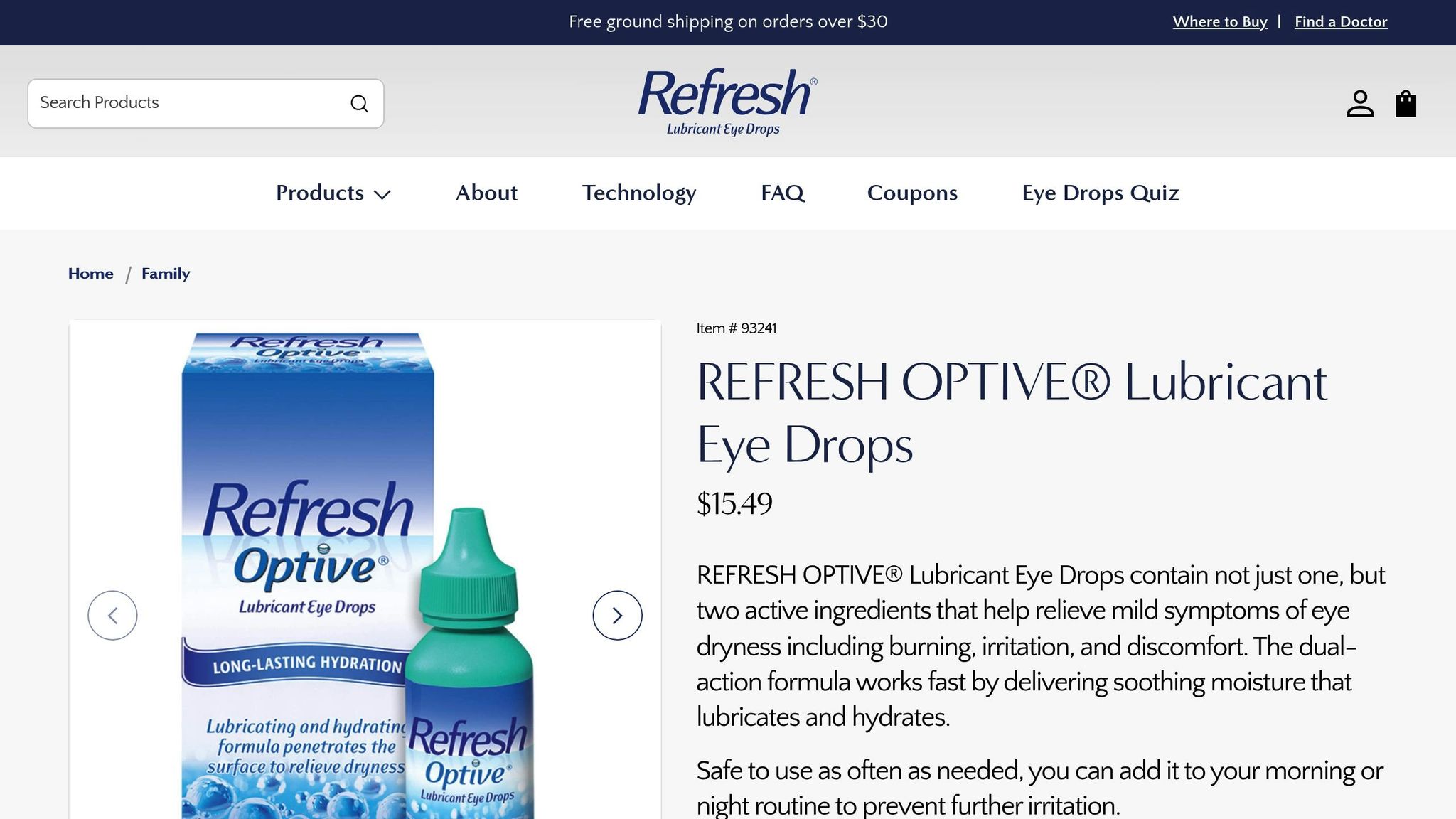
Refresh Optive Preservative-Free offers a dual-action formula designed to tackle common eye discomfort. It combines Carboxymethylcellulose sodium 0.5%, which provides lasting hydration, with Glycerin 0.9%, which adds lubrication to soothe burning, itching, and that annoying "something in your eye" feeling.
What sets this product apart is its preservative-free composition, packaged in convenient single-use sterile vials. This makes it an excellent option for those with sensitive eyes or anyone recovering from LASIK surgery (though you should always check with your doctor first).
When it comes to pricing, Refresh Optive Preservative-Free is reasonably competitive for a premium product. A 30-count box is priced at $15.99, while a 60-count box costs $33.49. Plus, it’s eligible for FSA or HSA reimbursement, adding some flexibility for those managing healthcare expenses.
As the #1 doctor-recommended artificial tears brand, Refresh brings more than 35 years of expertise in eye care to the table.
Use it whenever you need quick relief from dryness caused by wind, sun exposure, or other factors. Its single-use design makes it a convenient choice for keeping your eyes comfortable throughout the day.
3. TheraTears Lubricant Eye Drops
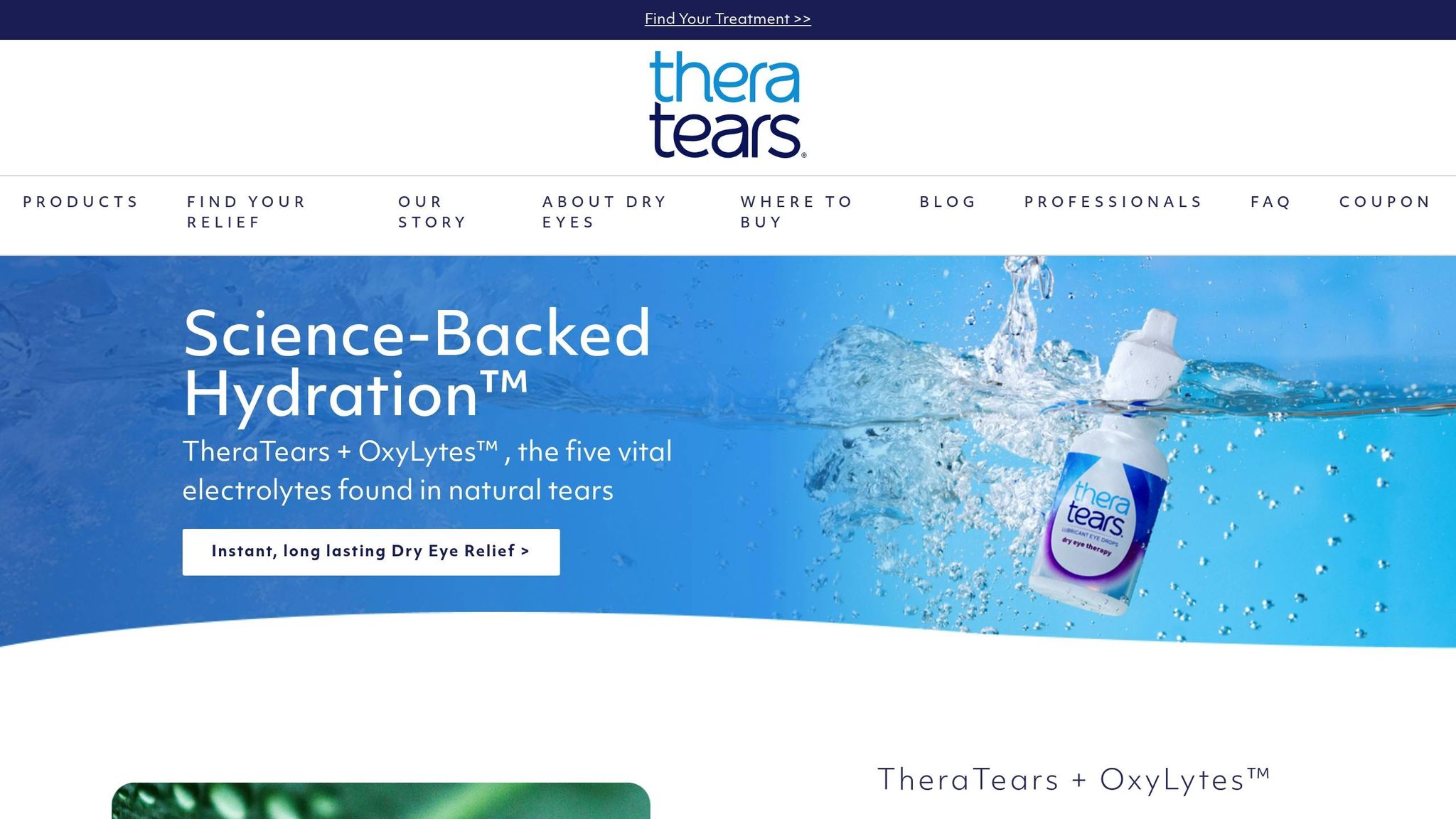
TheraTears stands out with its tear-like formula, featuring Sodium Carboxymethylcellulose 0.25% as the active ingredient. This ingredient creates a protective layer that helps lock in moisture, offering relief for dry, irritated eyes.
What sets TheraTears apart is its electrolyte-balanced formula, designed to mimic the salt content of natural tears. This balance supports the natural environment of your eyes, promoting comfort and proper function throughout the day.
The product comes in a multi-dose bottle that includes benzalkonium chloride as a preservative, making it suitable for those without sensitivities to preservatives.
TheraTears is particularly beneficial for computer users and office workers who deal with eye strain from long hours in front of screens. Its smooth consistency provides effective relief without the blurriness that thicker, gel-like drops can cause, making it ideal for tasks requiring clear vision.
Pricing is straightforward: a 15mL bottle typically costs $9–$13, while a 30mL bottle ranges from $15–$19. With up to four applications a day, it offers relief without leaving a sticky residue behind.
These features make TheraTears a convenient option for anyone navigating a busy office setting.
4. Thealoz Duo
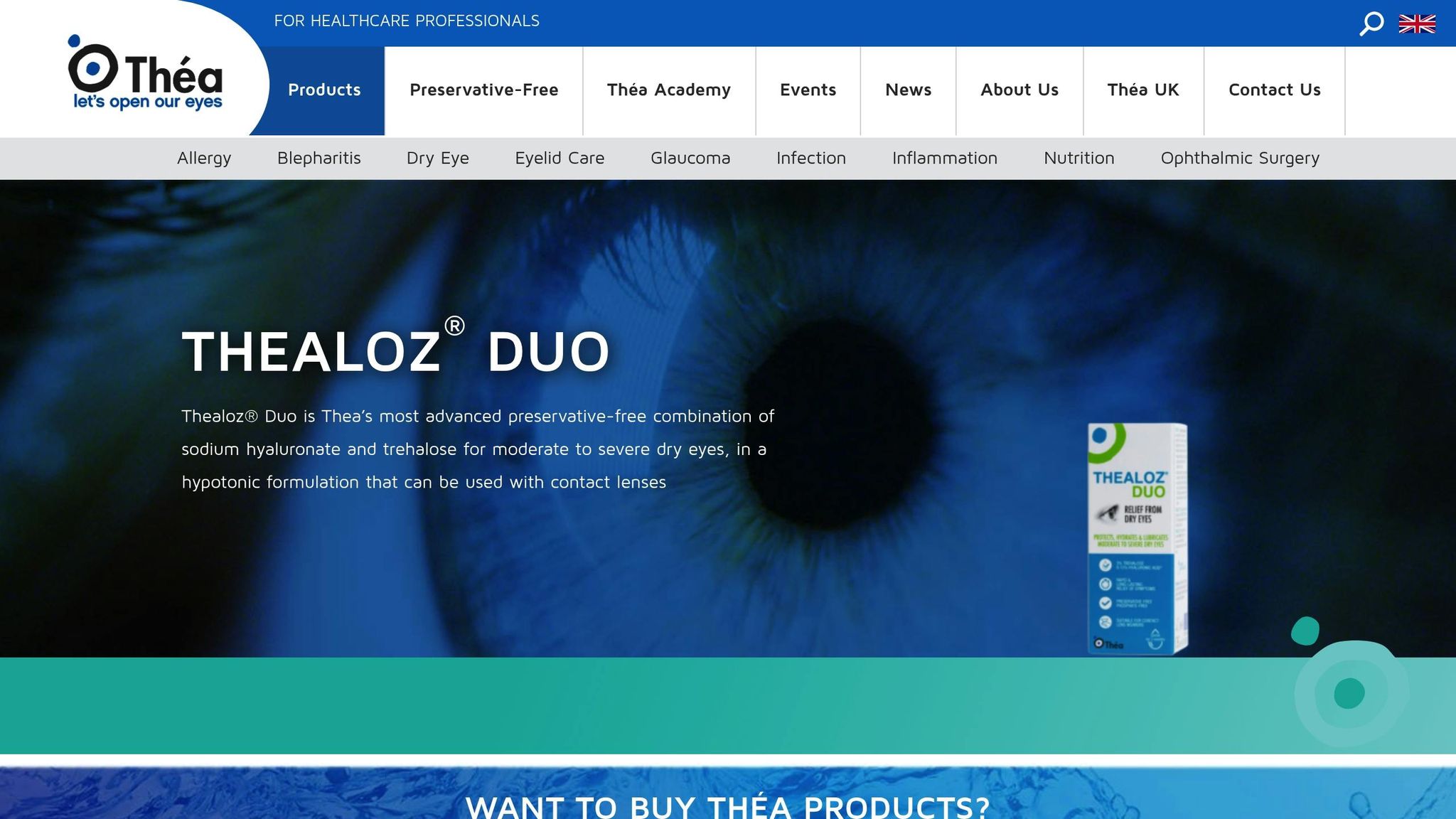
Thealoz Duo brings together trehalose and sodium hyaluronate to provide quick relief and long-lasting hydration for your eyes. Trehalose works to stabilize the tear film and shield the ocular surface, while sodium hyaluronate provides deep, soothing moisture.
What makes it even better? It’s preservative-free, making it a great choice for those with sensitive eyes. Plus, its sterile packaging is designed to stay that way even after opening, ensuring safe and reliable use over time.
5. Hyabak
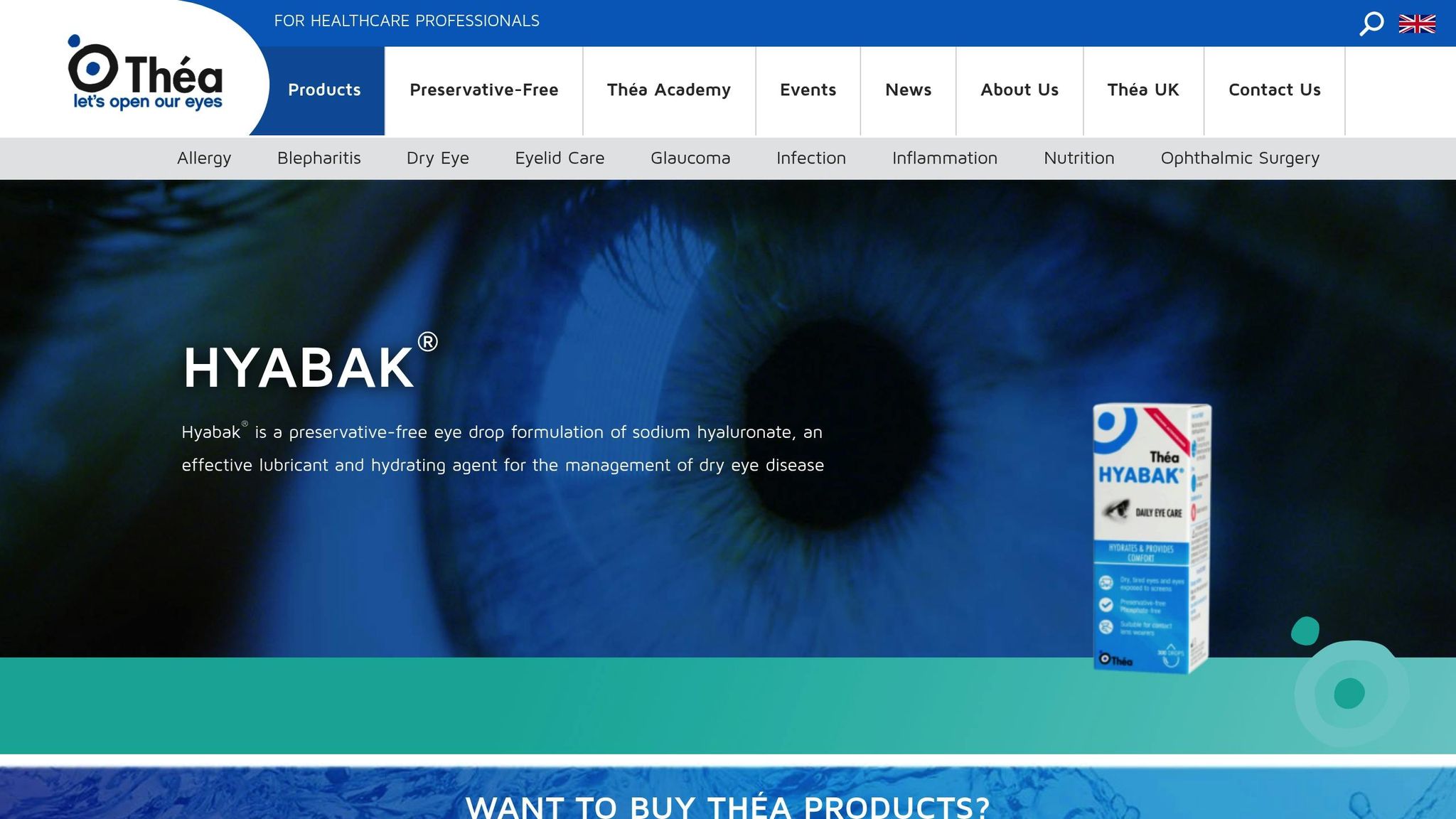
Hyabak is a standout option in the world of dry eye treatments, thanks to its 0.15% sodium hyaluronate formula. This natural polysaccharide works by hydrating and lubricating the eye surface, effectively locking in moisture where it’s needed most. Its hypotonic design addresses hyperosmolarity, reducing the saltiness of the tear film and easing dryness and that irritating gritty sensation. Plus, the formula is designed to mimic the natural viscosity of tears, ensuring a smooth and non-sticky experience.
What sets Hyabak apart is the addition of actinoquinol, an ingredient that protects against harmful UVB rays. This makes it a great choice for people who spend a lot of time outdoors. The preservative-free formulation is another big plus, as it lowers the risk of irritation and inflammation, making it suitable for daily use.
Hyabak has earned high praise from users, with Medino customers giving it an impressive 4.9 out of 5 stars based on 23,772 reviews – a testament to its effectiveness in relieving dry eye symptoms. It also boasts a 3–6-month shelf life after opening, offering convenience and value for those dealing with ongoing dry eye issues. With its combination of hydration, UV protection, and long-lasting usability, Hyabak delivers a thoughtful solution for modern dry eye care.
6. Systane Ultra
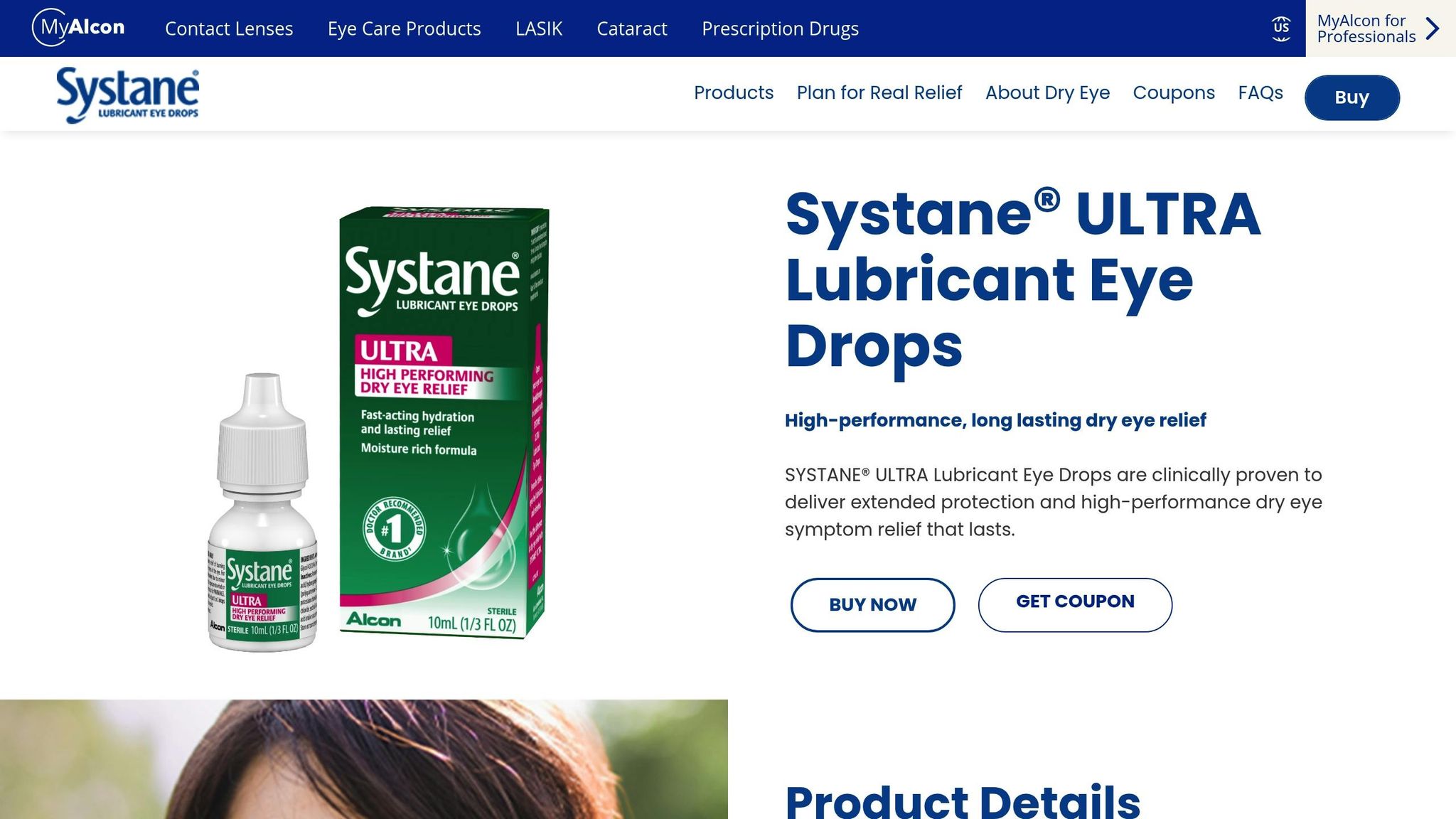
Systane Ultra stands out as a top-tier option for tackling moderate to severe dry eye. Its formula combines polyethylene glycol 400 (0.4%) and propylene glycol (0.3%) in a dual-polymer blend. What makes it unique? When it interacts with the eye’s natural pH and electrolytes, it transforms into a gel-like consistency. This helps lock in moisture and delivers longer-lasting relief compared to regular artificial tears.
The standard version includes polyquad (polyquaternium-1), a milder preservative compared to benzalkonium chloride. For those who use eye drops frequently or have sensitivities, preservative-free single-use vials are also available, though they come at a higher price.
Systane Ultra is particularly helpful for people who spend long hours in front of screens, work in offices, or frequently find themselves in dry environments like airplanes. Its thicker consistency means it stays on the eye longer, though it may cause brief blurriness right after application.
sbb-itb-5ef6ec9
7. Systane Gel Drops
Systane Gel Drops offer relief for severe dry eyes with a thicker gel-like formula. Thanks to their higher viscosity, these drops stay on the eye’s surface longer, making them a great option for nighttime use or when extended relief is needed. This lasting effect is achieved through a carefully crafted mix of active ingredients.
The drops feature a combination of polyethylene glycol 400, propylene glycol, and hydroxypropyl guar. Together, these ingredients create a protective gel layer that remains effective longer than standard eye drops. Hydroxypropyl guar also helps maintain the gel’s consistency, ensuring smooth and comfortable blinking.
It’s important to note that Systane Gel Drops are not preservative-free. They contain a small amount of POLYQUAD™ (polyquaternium-1) at a concentration of 0.001%. While this preservative is generally mild, those with highly sensitive eyes or allergies to preservatives should exercise caution when using this product.
Each 10mL Drop-Tainer™ bottle is designed to retain its effectiveness for up to three months after opening. However, these drops should not be used while wearing contact lenses. Be sure to apply them either before inserting your lenses or after removing them.
8. Refresh Celluvisc
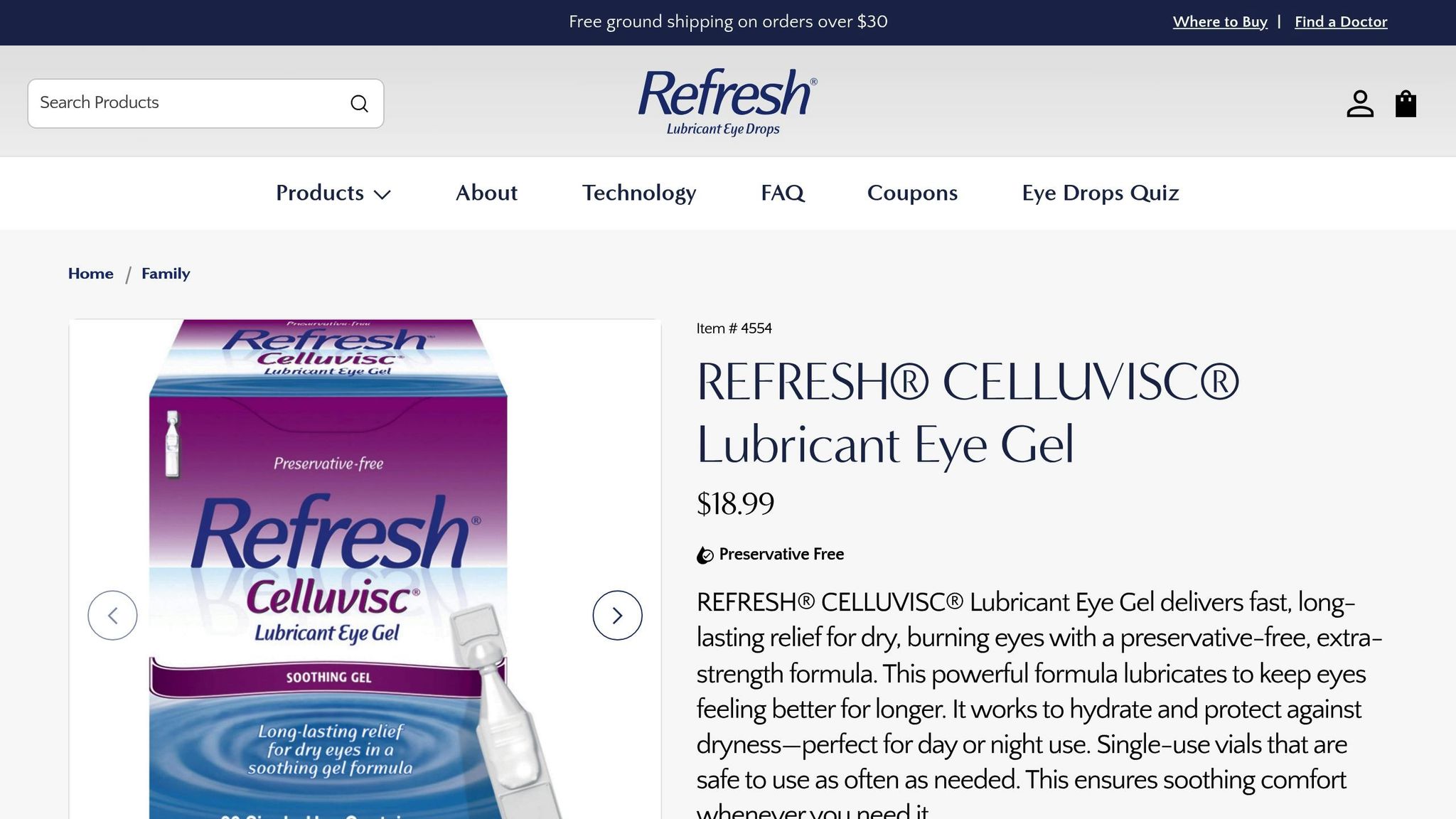
Refresh Celluvisc is a preservative-free eye drop designed for those dealing with severe dry eyes. Its active ingredient, carboxymethylcellulose sodium 1%, works as an artificial tear substitute, delivering much-needed moisture and relief for dryness.
What makes this product unique is how it transforms from a liquid drop into a protective gel upon contact with the eye’s natural pH. This gel-like coating provides extended relief by hydrating the eye surface and forming a protective barrier to prevent further dryness.
In terms of cost, Refresh Celluvisc falls into the mid-range price category for preservative-free eye drops. A box of 30 single-use vials is typically priced around $19.99, but discounts through SingleCare coupons can bring the price down to about $7.37. The single-use vial design also minimizes contamination risks, making it a safe choice for sensitive eyes. However, its thicker consistency may cause temporary blurring of vision, usually lasting 5 to 10 minutes after application.
Customer reviews reflect high satisfaction, with ratings of 4.6 out of 5 stars on Walmart.com and 4.5 out of 5 stars on Amazon. Users often praise the product for its long-lasting relief, particularly for nighttime use. That said, some have mentioned temporary blurring and occasional residue on eyelashes as minor drawbacks.
The formulation doesn’t stop at hydration. Inactive ingredients like calcium chloride, potassium chloride, sodium chloride, and sodium lactate help maintain the eye’s pH balance and add an extra layer of comfort. This combination makes Refresh Celluvisc a strong option for managing severe dry eye symptoms, especially when caused by environmental factors such as wind or sun exposure.
9. Restasis (cyclosporine)
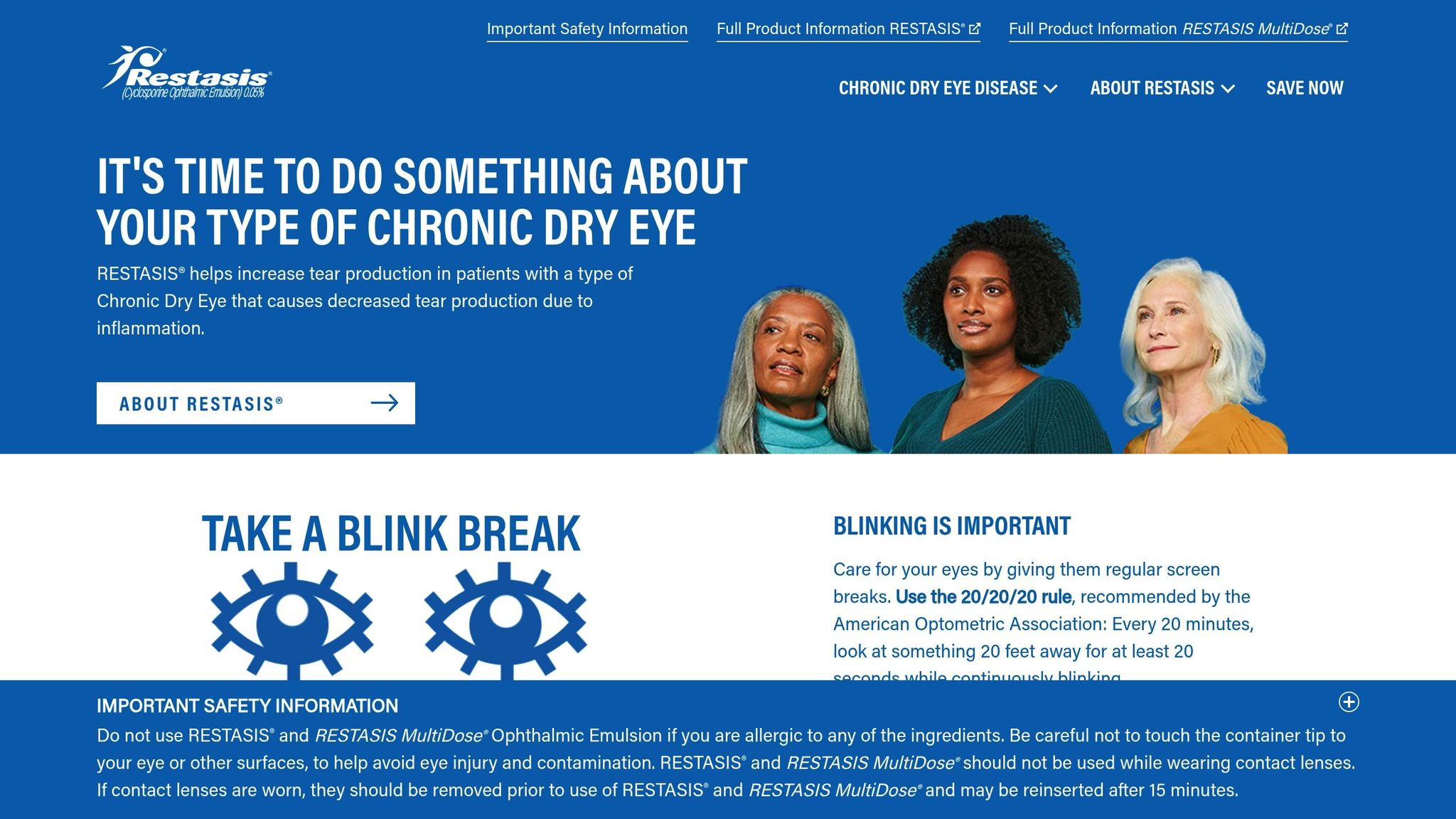
Restasis steps in as a prescription option for those dealing with chronic dry eye, offering a more targeted solution than over-the-counter products. Its active ingredient, cyclosporine 0.05%, works as an immunosuppressant, addressing the inflammation in the tear glands and on the eye’s surface that contributes to chronic dry eye disease.
What sets Restasis apart is its ability to reduce inflammation in the lacrimal glands, encouraging your eyes to produce more natural tears. Unlike over-the-counter drops, which simply add moisture, Restasis works at the root of the issue. However, it does require patience – most users notice improvements only after several months of consistent, twice-daily use.
While it’s on the pricier side, many insurance plans include coverage for Restasis if you have a diagnosed condition, and there are manufacturer programs available to help reduce out-of-pocket costs.
Using Restasis is straightforward: apply it twice daily, once in the morning and once in the evening. Each dose comes in a single-use vial, which should be discarded after use. Some people may experience mild burning or stinging when they first start using it, but this usually fades quickly.
For the best results, Restasis should be part of a broader dry eye treatment plan. Eye care professionals often recommend pairing it with artificial tears during the early stages of treatment. In more severe cases, additional therapies like punctal plugs or other anti-inflammatory medications might be necessary.
Restasis isn’t suitable for everyone – it should be avoided if you have an active eye infection. If you have an autoimmune condition, your doctor will need to monitor you closely while you’re using it. Regular follow-ups are crucial to ensure the treatment is working as intended and to address any concerns.
10. Xiidra (lifitegrast)
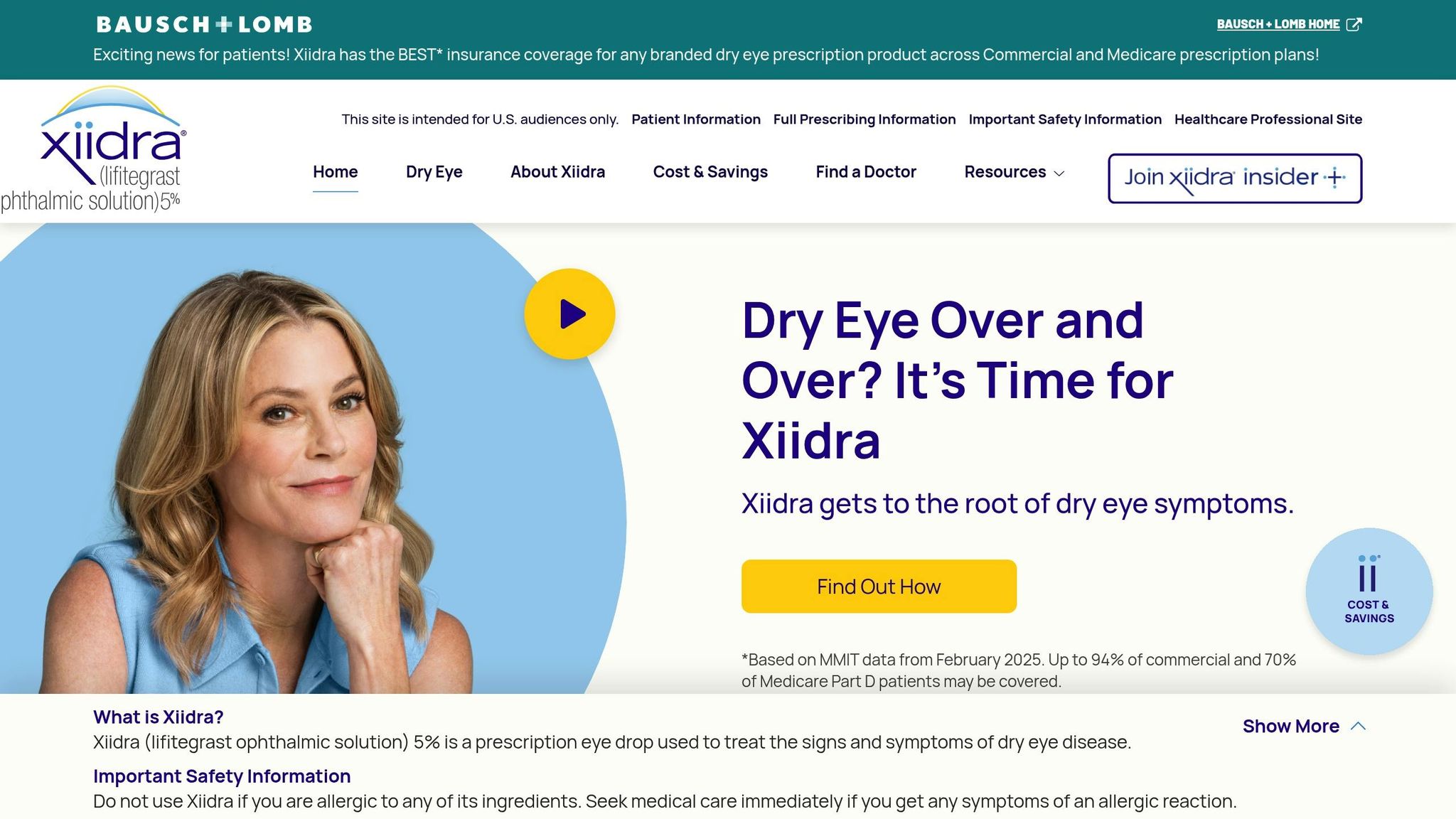
Xiidra is a prescription treatment designed for chronic dry eye, offering a different approach compared to Restasis. Its active ingredient, lifitegrast 5%, works by targeting inflammation. Specifically, it prevents inflammatory cells (LFA-1) from binding to proteins (ICAM-1) on the surface of the eye. This action helps reduce the inflammation that often causes dryness, burning, and irritation.
"Xiidra stands out by targeting the underlying inflammation, which is the root cause of dry eye symptoms." – Westwood Ophthalmology Associates
One of Xiidra’s key advantages is its relatively quick results. Clinical studies have shown noticeable improvements as early as 14 days, with continued benefits observed at 2, 6, and 12 weeks in various OPUS studies.
Xiidra is an excellent option for adults dealing with chronic dry eye disease, particularly those who frequently experience dryness, irritation, or a gritty sensation. It’s also a valuable choice for individuals with autoimmune conditions like Sjögren’s syndrome, rheumatoid arthritis, or lupus, as these conditions often exacerbate dry eye symptoms. Additionally, Xiidra is commonly recommended for patients preparing for eye procedures such as LASIK or cataract surgery, as it helps to optimize the health of the eye’s surface beforehand.
"For those seeking faster symptom management, Xiidra is ideal, helping reduce inflammation and relieve symptoms like dryness, irritation, and discomfort more quickly." – Westwood Ophthalmology Associates
When it comes to cost, Xiidra is a practical choice for many patients. It boasts strong insurance coverage, with up to 94% of commercially insured patients and 70% of Medicare Part D patients having access to it. For eligible commercially insured patients, the Xiidra Savings Card can bring costs down to as little as $0. Additionally, it’s preferred on several Medicare Part D plans, including SilverScript Medicare, Aetna Medicare, and Cigna Medicare.
Patient adherence to Xiidra further highlights its effectiveness and tolerability. In a study of 600 patients, over 80% continued using Xiidra after one year, with many reporting noticeable improvements within three months. A review of health records from more than 7,000 dry eye patients also revealed that those using Xiidra stuck with their treatment longer and discontinued less often compared to other prescription eye drops.
Xiidra is applied twice daily using single-use vials. While some patients report mild side effects, such as slight eye irritation or an unusual taste, nearly eight years of safety data (2016–2024) confirm that these effects are consistent with clinical trials, with no new safety concerns identified. As with many prescription treatments, prior authorization from insurance providers may be necessary, so it’s a good idea to discuss coverage details with your doctor.
Advantages and Disadvantages
Weighing the pros and cons of each product can help you find the best fit for your specific needs.
| Product | Advantages | Disadvantages |
|---|---|---|
| Systane Complete PF | Preservative-free formula minimizes irritation; works well for sensitive eyes and frequent use; offers broad lubrication | Higher cost compared to preserved options; single-use vials may be less convenient |
| Refresh Optive Preservative-Free | Gentle on sensitive eyes; safe for extended use; dual-action formula; compatible with contact lenses | Costs more per dose; carrying multiple vials can be inconvenient |
| TheraTears Lubricant | Electrolyte-balanced formula mimics natural tears; effective for mild to moderate dryness | Might not provide enough relief for severe dry eye cases |
| Thealoz Duo | Combines trehalose and hyaluronic acid to repair the eye surface; preservative-free | Premium price tag; availability may be limited in some areas |
| Hyabak | High concentration of hyaluronic acid; effective for severe dryness; preservative-free | Expensive; may temporarily blur vision after application |
| Systane Ultra | Long-lasting relief; widely available; offers good value | Contains preservatives that could irritate sensitive eyes with frequent use |
| Systane Gel Drops | Thicker consistency delivers extended protection; great for nighttime use | May temporarily blur vision; preservatives could cause irritation over time |
| Refresh Celluvisc | Simple formula with minimal risk of allergic reactions; preservative-free | Basic formulation may not address more complex dry eye issues |
| Restasis | Treats underlying inflammation; boosts natural tear production; offers proven long-term benefits | Expensive; may take months to show full results; possible side effects |
| Xiidra | Provides quick relief; targets inflammation at its source; often covered by insurance | Requires a prescription; may leave an unusual taste; prior authorization is often needed |
To break it down further: Preservative-free options are gentle on the eyes, reducing irritation and long-term risks, but they tend to be pricier and rely on single-use vials. Preserved formulas, on the other hand, are more affordable and convenient, especially for occasional use, but they may irritate sensitive eyes with frequent application. Prescription treatments, like Restasis and Xiidra, tackle the root causes of chronic dry eye but often require patience, higher costs, and a prescription process.
Consider your frequency of use, sensitivity to preservatives, and budget to select the most suitable eye drop for your needs.
Final Thoughts
When choosing eye drops, match them to your specific symptoms. For mild dryness, basic artificial tears like TheraTears or Refresh Celluvisc can do the trick. If you’re dealing with moderate to severe dryness, consider advanced options like Systane Complete PF or Thealoz Duo for better results.
If you need to use drops frequently or have sensitivities, go for preservative-free options such as Refresh Optive PF or Hyabak. On the other hand, preserved formulas like Systane Ultra can be a more budget-friendly choice if your use is occasional.
For those with chronic inflammation, prescription treatments like Restasis or Xiidra can address the underlying causes rather than just masking symptoms. However, keep in mind that these treatments may take time to show results.
Your lifestyle also plays a role in finding the right solution. Contact lens wearers should pick drops designed for compatibility with lenses. If dryness worsens at night, thicker gel drops can provide relief while you sleep. And if you’re watching your budget, starting with basic artificial tears is a good approach, with the option to switch to premium formulas later if needed.
For persistent symptoms, it’s crucial to consult an eye care professional. Chronic dryness could indicate more serious issues like meibomian gland dysfunction, autoimmune conditions, or side effects from medications. A professional can perform in-depth evaluations, recommend the right treatments, and track your progress to ensure long-term relief.
FAQs
What makes preservative-free eye drops a good choice for dry eyes?
Preservative-free eye drops are a great choice for relieving dry eyes, especially if you have sensitive eyes or need to use them often. Unlike regular eye drops, these don’t include chemicals that might irritate or harm the delicate surface of your eyes over time.
Because they’re formulated to be gentler, they’re well-suited for long-term use or for managing chronic dryness. They also reduce the chances of triggering allergic reactions, offering a more soothing and comfortable experience. If you’re searching for a safe and effective way to ease dry eye symptoms, preservative-free drops are a smart option to consider.
How do prescription eye drops like Restasis and Xiidra help manage chronic dry eye?
Prescription eye drops like Restasis (cyclosporine) and Xiidra (lifitegrast) are commonly used to treat chronic dry eye by targeting the inflammation that interferes with tear production.
Restasis helps by calming the immune response in your eyes, which gradually boosts your natural tear production. Xiidra, on the other hand, works by blocking a specific protein linked to inflammation, helping to stabilize and rebuild the tear film.
Both medications are effective but work in distinct ways. Talk to your eye care provider to figure out which option aligns best with your specific needs and daily routine.
What should I consider when selecting the best eye drops for my dry eye symptoms?
When selecting eye drops for dry eyes, it’s important to match the product to your specific symptoms and needs. For mild dryness, artificial tears with low viscosity can offer quick and effective relief. If you find yourself needing drops frequently or have sensitive eyes, preservative-free options are a safer bet to minimize irritation.
For more severe dryness, it helps to understand the root cause. If your dry eyes stem from evaporative issues, look for drops containing lipids to support and stabilize your tear film. On the other hand, if the problem is tied to aqueous deficiency, choose drops specifically formulated to boost hydration. Also, consider how often you plan to use the drops and whether you have any pre-existing eye conditions. For persistent or chronic symptoms, it’s always a good idea to consult an eye care professional to get tailored advice.





